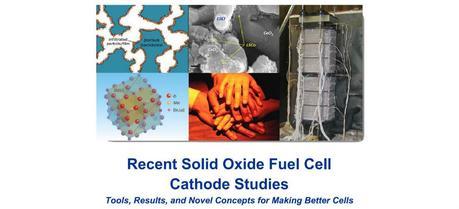
A solid oxide fuel cell (SOFC) is an electrochemical conversion device that produces electricity directly from oxidizing a fuel. Advantages of this class of fuel cells include high efficiency, long-term stability, fuel flexibility, low emissions, and relatively low cost. The largest disadvantage is the high operating temperature which results in longer start-up times and mechanical and chemical compatibility issues.
And with continued advancements, solid oxide fuel cells can provide clean electricity from a variety of low-cost domestic energy resources and position U.S. industry to commercialize a clean energy technology. Now, a compilation of studies examining cathodes for solid oxide fuel cells is available on the Department of Energy’s (DOE) National Energy Technology Laboratory (NETL) website. The report, entitled Recent Solid Oxide Fuel Cell Cathode Studies, provides a concise, portfolio-wide synopsis of cathode research conducted under the Office of Fossil Energy’s Solid Oxide Fuel Cells Program.
Fuel cell technology has been around for more than a century, but it didn’t find commercial application until the 1950s, when NASA required a compact way to generate electricity for space missions. Fuel cells have been used in practically every NASA mission since the 1960s, and have begun the transition to other, more widespread applications
A variety of fuel cell types exist, but they all have the same general make-up: an anode (negative side), a cathode (positive side), and, sandwiched in between, an electrolyte that allows charges to pass from one side to the other. Because the main difference between fuel cells is the electrolyte, they are classified by the type of electrolyte used. In a solid oxide fuel cell, the electrolyte is a solid ceramic material. The anode and cathode are made from highly engineered materials that convert fuel and air into electricity.
In 1999, The Office of Fossil Energy created the Solid State Energy Conversion Alliance, now the Solid Oxide Fuel Cells Program, to accelerate the development of solid oxide fuel cells and get them to market as quickly as possible. The NETL-managed program is currently developing solid oxide fuel cells for large power plants. The same technology is also likely to find distributed-generation applications, such as grid support, remote power, and combined heat and power.
In 2007, the program began a focused effort to correlate the surface attributes of common solid oxide fuel cell cathodes with performance and stability. Additionally, various cathode infiltration techniques and material sets were investigated to assess the potential for improved performance and stability. These studies resulted in the creation of multiple papers, written by program researchers, which have been compiled in the new report. Highlights of the report include—
- New surface property data—The surface chemistry of the state‐of‐the‐art cathode materials were characterized under solid oxide fuel cell operating conditions in situ.
- In situ/ex situ correlations—The surface chemistry of cathodes was characterized under in situoperating conditions and temperatures down to room temperature ex situ.
- In situ tools—Synchrotron‐based x‐ray techniques were used heavily to study the surfaces of model thin‐film cathode materials providing surface chemistries, crystal structures, and valence states.
- Infiltration—A number of cathode infiltration architectures were investigated and tested at lab scale.

